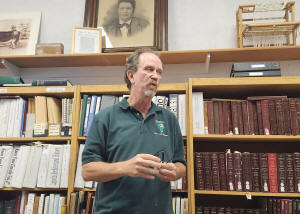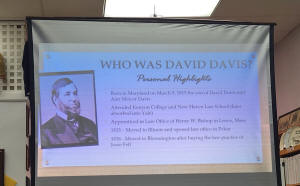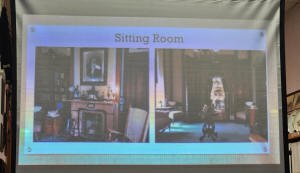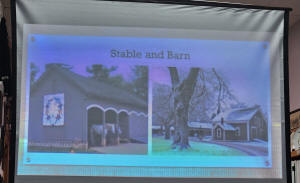|
At the July 21 Logan County
Genealogical and Historical Society meeting, the speaker was Jeff
Saulsberry, site manager of the David Davis mansion in Bloomington,
Illinois.
Besides being the site manager for the David Davis mansion,
Saulsberry serves as site manager for Postville Courthouse, Mt.
Pulaski Courthouse, Metamora Courthouse and Jubilee College State’s
Historic Site.

Saulsberry began his presentation
with information about David Davis, who was a friend of Abraham
Lincoln when Lincoln was a lawyer on the Illinois circuit.

David Davis was born in Maryland
March 9, 1815, to David Davis and Ann Mercer Davis. His father was
kicked in the head and died before David was born.
Davis’s stepfather took David’s inheritance and sent Davis off to
Kenyon College at age 14 telling Davis to “go and be a man. Good
luck in life.” Saulsberry said Davis later tried to sue his
stepfather to get his money back. It was only $5000 at that time,
but today that would be worth roughly $100,000.
Davis not only attended Kenyon College but also helped build it. He
then went to New Haven Law School, which was later absorbed into
Yale University.
For his apprenticeship, Davis worked in the Law Office of Henry W.
Bishop in Lenox, Massachusetts.

In 1835, Davis moved to Illinois
and opened a law office in Pekin, which Saulsberry said was then a
dirty river town with lots of gambling.
As of 1836, Davis moved to Bloomington after buying the law practice
of Jesse Fell. Saulsberry said Fell owed Davis money, which helped
with the purchase of the practice.
Davis married Sarah Woodruff Walker of Lenox, Massachusetts in 1838.
She was the daughter of William Perrin Walker, Judge of Probate for
Berkshire County.
When Davis had originally asked Judge Walker for Sarah’s hand in
marriage, Davis wanted a three year engagement. Her father said no
and told Davis, go make your fortune and set yourself up then come
back and talk to me and we will see what happens.
Davis was able to write to Judge Walker showing what he had done,
what people paid him and where he was financially. He then asked
Walker “can I marry your daughter?” This time, Walker told Davis
yes.
After David and Sarah Davis got married, the couple returned to
Bloomington in December 1838. Saulsberry said George Herbert Walker
Bush was a descendant of the Walker family.
The Davises had seven children, but only two lived to adulthood. The
other five died in infancy. George Perrin Davis was born in 1842,
and Sarah “Sally” Worthington Davis was born in 1852.
In 1845, Davis purchased the farmhouse and land where the current
mansion sits from Jesse Fell. Between 1870 and 1872, a new mansion
was built on the same site where the farmhouse had been.
Personal highlights for Davis include being a lawyer, judge,
businessman, landowner and personal friend of Abraham Lincoln.
Saulsberry shared a timeline of Davis’s career and political
highlights. Davis was admitted to the Illinois bar in 1836. In the
1830s, Davis began travelling the 8th Judicial Circuit as a lawyer.
At its peak, this circuit covered fifteen counties.
By 1844, Davis won election to the Illinois Legislature as a Whig.
He chaired the judicial committee of the Illinois Constitutional
Convention in 1847 and helped write the Illinois Constitution.
Saulsberry said it was almost guaranteed Davis would be elected
Judge of 8th Judicial Circuit.
In 1860, Davis became Lincoln’s campaign manager at the Republican
Convention in Chicago. Edward Achorn’s book The Lincoln Miracle:
Inside the Republican Convention that Change History tells the story
of Lincoln’s nomination to lead the Republican Party in the 1860
presidential election. Saulsberry said Lincoln was a “Dark Horse”
with William Seward expected to win the election.
Some thought Seward would not win the election because he was so
radical and said there was going to be a Civil War. There was no
question they would have to fight to be all slave or all free.

Saulsberry said Lincoln said the
same thing, but it was a little less radical. He said Kentucky guys
talked to the Kentucky delegates and New England guys talked to the
New England delegates and on and on [with other state delegates].
The first ballot had Seward on top, but Saulsberry said the majority
did not have enough to win. On the second ballot, more started
voting for Lincoln and by the third ballot, it was unanimous for
Lincoln.
What Lincoln did for Davis was to put Davis on the United States
Supreme Court in 1862. After Lincoln was assassinated, Robert Todd
Lincoln asked Davis to take charge of Lincoln’s affairs and be
administrator of Lincoln’s estate. Saulsberry said it took about two
years to settle the estate and pay all of Lincoln’s debts. Davis
also became the guardian of Tad Lincoln because a woman could not be
the guardian of her own child at that time.
Davis got Robert Todd Lincoln started in business. By the time Davis
settled the estate, it was worth $75,000. Today that would be 1.8
million dollars.
In 1866 Davis wrote the majority opinion of Ex Parte Milligan, a
landmark case that ruled the use of military tribunal to try
citizens when civil courts are operating is unconstitutional.
Saulsberry said Milligan was a copperhead who tried to desert [the
army] and sow dissent behind the lines in the Union and was
sentenced to death. Lincoln commuted Milligan’s sentence, but later
on a case went to the Supreme Court. The law is still used today.
Davis was elected to the U.S. Senate by the Illinois Legislature in
1877. Then from 1881 to 1883, Davis was elected as Senate President
pro-tempore after the assassination of President James Garfield.
Saulsberry said that made Davis the de facto President of the United
States. Davis served under President Chester Arthur, who called
Davis Vice President, though history books do not record that
information.
The David Davis Mansion

Saulsberry then talked about the
David Davis mansion, which is known as Clover Lawn. He said it is a
magnificent place that has been written about in magazine articles
that also referred to the Rockefeller home an Biltmore Estate.
The mansion was built in 1872 for David and Sarah Davis. It was
designed by French born architect Alfred Piquenard, who told Davis
it would take six months and cost $35,000 to build the house.
Instead, Saulsberry said it took two years and cost $75,000 to build
the house. When the house was later restored, the cost was over two
million dollars.
The mansion’s gilded age style combines both Italianate and Second
Empire Architectural features. It was 14,000 square feet. The
basement has nine foot ceilings, the first floor ceilings are
thirteen and a half feet and the second floor ceilings are twelve
and a half feet.

The interior of the mansion
includes a sitting room, parlor, formal dining room, library and
kitchen. There are seven bedrooms and two bathrooms. Saulsberry
showed photos of several rooms.

Modern amenities
in the mansion included indoor plumbing, a radiant heat furnace,
speaking tubes, an annunciator panel and call bell systems and
gas lighting. The stove in the kitchen is cast iron and the sink
is soapstone. The west wall of the kitchen has metal cabinets.
Above the sitting room fireplace is a portrait [of Davis] called
a crayon drawing that looks like a photograph. Saulsberry said
the portrait was done by Dennis Williams, an African American
man from Springfield. The portrait was commissioned by Davis’s
son after Davis’s death.
[to top of second column] |


Also on the property are a stable
and barn. Saulsberry said the barn is the oldest building on the
property, as it was built around 1850. A quilt pattern on the side
of the barn had to be taken down in recent years because it started
causing problems with the wood behind it.
Other buildings on the property are a woodshed, which houses a
restroom and storage and a Visitor’s Center, which Saulsberry said
is a 1965 ranch house.

Sarah Davis’s garden is a living
history set up exactly how she had it in 1872. Saulsberry said most
older homes do not have original gardens like this one. The
starburst garden is patterned after Classical Italianate gardens of
the 17th century and formal English gardens of the 18th century.
This garden contains 70 species of the original 120 [species]
documented in Sarah’s letters. Fourteen of the plants marked
throughout the garden are Sarah’s original. Saulsberry said they are
trying to replace the [original] plants that are missing, but it is
very hard to get heirloom plants. Fortunately, they were lucky to
get geraniums from Monticello [home of Thomas Jefferson]. Master
Gardeners are vital for the restoration and maintenance of the
garden.
Landscape preservation consultant and Historian Scott Kunst saw the
garden and was blown away by so much being original. Kunst said,
“the upper garden is a national treasure and very rare and fragile
artifact. What’s incredibly special about the garden is that it is
not a reproduction but a real, surviving fragment of the past…”
Davis family letters were transcribed and annotated by David Davis
Mansion Foundation (DDMF) Historian Patricia Schley. Saulsberry said
they are slowly transcribing every letter the judge and Sarah and
also family members wrote to one another. These letters are housed
at Illinois Wesleyan University. The letters can also be easily
accessed by searching online for “David and Sarah Davis Family
Correspondence.” Letters Abrahm Lincoln is mentioned in will come
right up if that is added to the search.
The David Davis Mansion is open Wednesdays through Saturdays from
9:30 a.m. to 4:00 p.m with the last tour starting at 3:30 p.m..
Saulsberry said 1000s of students used to visit the mansion on field
trips, but after COVID, there are much fewer students visiting.
Special events include Lincoln’s birthday, an Easter egg hunt, a
garden festival the second weekend in July, Christmas at the mansion
the second Saturday in December and Gilded Age Christmas. Saulsberry
said there are car shows on the mansion grounds during the summer.
At school programs, Saulsberry said city kids would visit and get to
see a horse for the first time. They would also make butter by
shaking heavy cream in a jar. When they put the butter on a cracker,
he said one would think they had been given slices of chocolate
cake.

In the Clover Lawn Gift Shop,
people can purchase the David Davis Biography, several Lincoln
related titles, heirloom seeds from Sarah’s garden, ornaments, toys
and many miscellaneous items.

A special edition book by Marsha
Young published in 2022 to celebrate the 150th anniversary of the
David Davis mansion is also available in the gift shop. The book is
$100 and tells the story of how the house came to be.
The David Davis Mansion Historic Site is now operated under [the
guidance of] the Illinois State Museum and its Board of Directors.
Saulsberry said initially, the site was under the Department of
Conservation, then they created a Historic Preservation Agency. For
a long time, the site was owned and operated by the Illinois
Department of Natural Resources, an agency of state government.
This site is also supported by the David Davis Mansion Foundation,
whose mission is to educate the public about local, state and
natural history through the use of the Mansion and its collections,
special events and Davis family papers.
When Saulsberry finished his presentation, he asked if there were
any questions.
Diane Farmer asked about Jesse Fell and his connections to Illinois
State University. She also wanted to know whether Davis resigned
from the United States Supreme Court to be Senator.
Saulsberry said Fell was a lawyer and a friend of both Davis and
Lincoln. Fell was one of the people who talked Lincoln into running
for President. Fell’s story is best told at the McLean County Museum
of History.
Davis resigned from the Supreme Court to be a Senator. Saulsberry
said at that time, being a Senator was more prestigious than being
on the Supreme Court. Some hoped Davis, by then an Independent,
could help Samuel J. Tilden win the 1876 presidential election
[against Rutherford B. Hayes] by being swayed to the Democratic
side. However, Davis decided not to serve on the committee that had
to decide the winner when there was an impasse in the election [due
to some questionable electoral votes].
Joanne Marlin asked how many volunteers it takes to run the mansion.
Saulsberry said it takes roughly 70 volunteers for the mansion and
close to 100 volunteers to care for the gardens. More volunteers are
needed at places like Postville Courthouse, so he encouraged
everyone to consider volunteering at Postville.
Beverly Buhrmester asked when the mansion became a historical site
and whether all the buildings and furnishings were original.
In 1959, the mansion was going to be knocked down, but Saulsberry
said that was stopped. The state asked David Davis the fourth for
Lincoln and Davis correspondence, especially telegrams sent during
the election, from Davis’s estate.
One telegram from Davis to Abraham Lincoln said, “we are moving
heaven and earth to get you nominated.” When Lincoln responded with
“make no promises that bind me,” Davis said to the guys working on
Lincoln’s election “he doesn’t know what we are going to have to do
to get him elected.”

David Davis the fourth said the
state could have the telegrams but wanted tax breaks on the estate.
He also wanted them to take the Davis home and make it an
educational institution for future generations.
In 1960, the state agreed to make the mansion and grounds of Clover
Lawn a historical museum. Saulsberry said it was open to the public
for tours by the mid-1960s.
Neighbors complained about the mansion. Saulsberry said people were
writing to Robert Bone [who ISU’s Bone Student Center is named
after] wanting the outbuildings and the wooden buildings on the
property torn down.
A year or two later, people sent letters saying there were raccoons,
rats, mice and vermin crawling through these buildings. Bone just
put those letters in a drawer and his non-action helped ensure the
buildings stayed up. Just a few shanties like chicken coops were
torn down.
The property is now four and a half acres. Saulsberry said it used
to be 1200 acres, but most of the farm acres were sold off due to
not being farmed as much.
The visitor’s center opened about 14 years ago.
Saulsberry said many of the furnishings in the mansion are original.
Curt Fox asked how many generations of the Davis family lived in the
mansion. He also wondered if the living descendants of Davis
appreciate their heritage.
Saulsberry said there were three generations of the Davis family
that lived in the mansion. Someone from the sixth generation of the
family is on the DDMF board. There are seventh generation members of
the family now. Some of the descendants still live in the area and
Saulsberry said they appreciate their heritage. One of his
descendants helps with the garden walk.
The August LCGHS program will be presented by Rick Klinedisnst, who
will talk about Camp Ellis, a former World War II Prison of War camp
near Ipava, Illinois.
[Angela Reiners] |